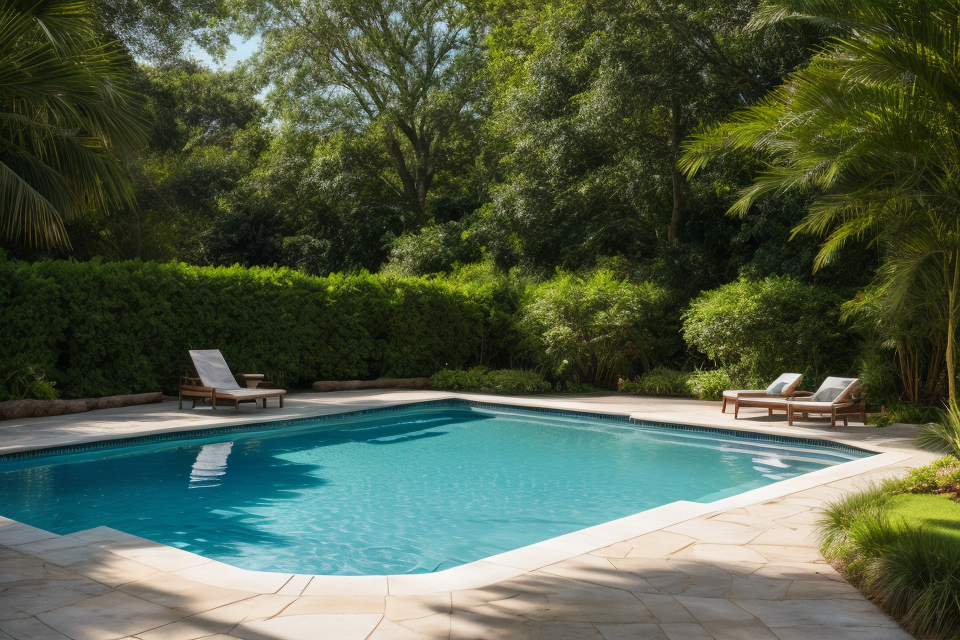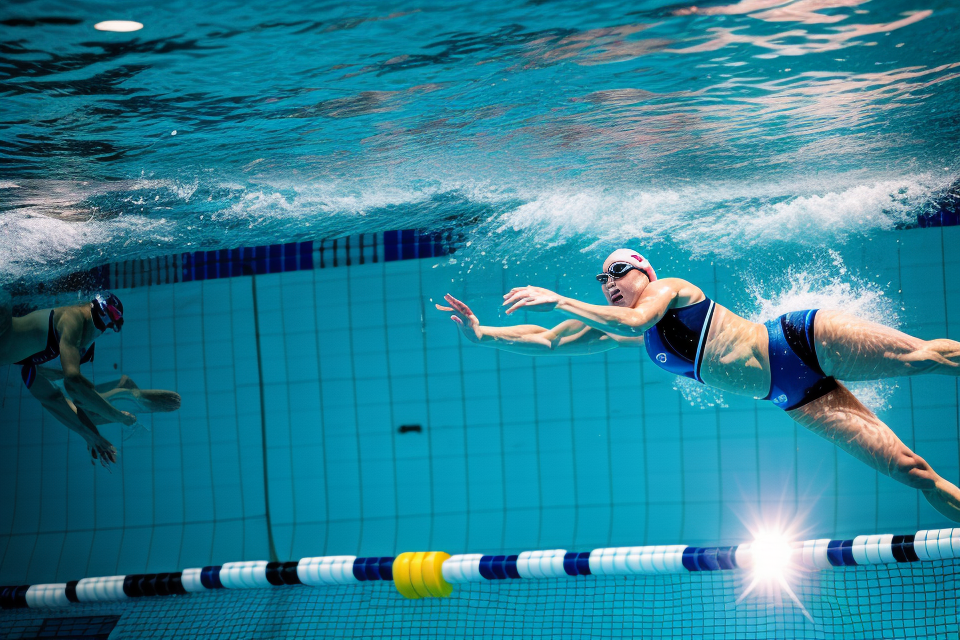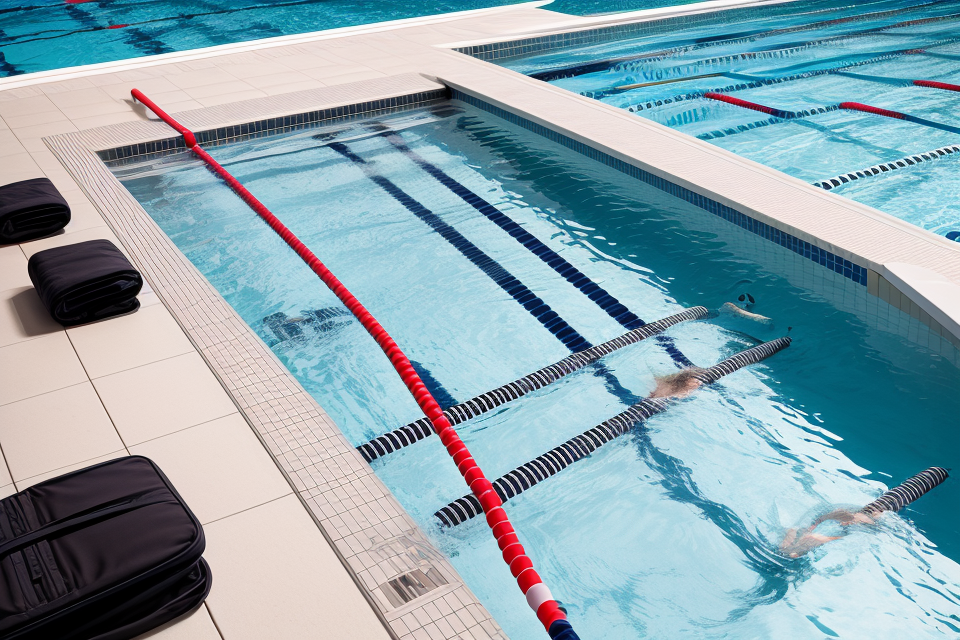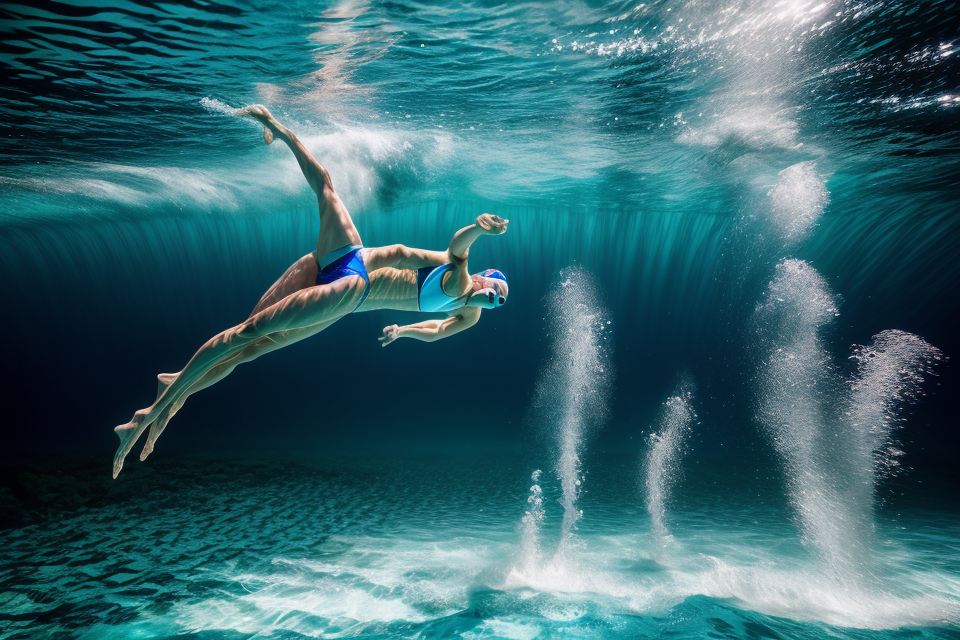Are you tired of being left behind in the pool? Do you often wonder why you’re not as fast as the other swimmers? Fear not, for you’ve come to the right place. In this comprehensive guide, we’ll delve into the reasons why you may not be reaching your full potential in the water. From improper technique to lack of training, we’ll cover it all. So, whether you’re a beginner or an experienced swimmer, this guide is perfect for anyone looking to improve their swimming speed. Get ready to take your swimming game to the next level!
Understanding the Basics of Swimming Speed
Factors Affecting Swimming Speed
Physical Attributes
Physical attributes play a significant role in determining one’s swimming speed. These attributes include:
- Body size and shape: The body size and shape can affect the amount of drag that is created while swimming. For example, swimmers with larger surface areas may generate more drag, which can slow them down.
- Muscle mass: Muscle mass is essential for swimming speed, as it provides the power needed to move through the water. However, too much muscle mass can also create drag, so it’s important to find the right balance.
- Body composition: Body composition can also impact swimming speed. Swimmers with higher fat percentages may have more resistance in the water, while those with higher muscle percentages may have an advantage.
Technique
Technique is another crucial factor in swimming speed. The way a swimmer moves through the water can greatly impact their speed and efficiency. Some key factors in technique include:
- Stroke mechanics: The way a swimmer executes each stroke can greatly impact their speed. For example, a swimmer with a poor catch (the initial hand entry into the water) may struggle to generate power and speed.
- Breathing: Breathing is essential for maintaining a consistent rhythm and staying relaxed while swimming. Swimmers who hold their breath or breathe irregularly may struggle to maintain a fast pace.
- Kick: The kick is an often-overlooked aspect of swimming technique, but it can greatly impact speed. A strong kick can help generate thrust and maintain a consistent rhythm.
Training
Training is crucial for improving swimming speed. Regular practice and structured workouts can help swimmers build endurance, strength, and technique. Some key aspects of training include:
- Dryland training: Dryland training, or exercises done outside of the pool, can help swimmers build strength and improve technique. Exercises such as plyometrics, weightlifting, and yoga can all be beneficial for swimmers.
- Interval training: Interval training involves alternating periods of high-intensity exercise with periods of rest. This type of training can help swimmers build endurance and improve speed.
- Swim-specific drills: Swim-specific drills are exercises that mimic the movements of swimming. These drills can help swimmers improve technique and build muscle memory.
Equipment
Equipment can also play a role in swimming speed. The right gear can help improve comfort, efficiency, and speed. Some key pieces of equipment include:
- Swimsuits: Swimsuits can greatly impact a swimmer’s speed and comfort in the water. Fast-sinking suits can provide extra buoyancy and help swimmers stay afloat, while tight-fitting suits can reduce drag.
- Goggles: Goggles can help improve vision and comfort in the water. Different types of goggles can provide different levels of vision and comfort, so it’s important to find the right pair for your needs.
- Swim caps: Swim caps can help reduce drag and improve comfort in the water. Different types of caps can provide different levels of drag reduction and comfort, so it’s important to find the right one for your needs.
Importance of Proper Technique
Proper technique is essential for reducing resistance, maximizing efficiency, and preventing injuries in swimming.
- Reducing Resistance
When you swim, you generate resistance from the water. Proper technique helps to minimize this resistance, allowing you to move through the water more efficiently. For example, a streamlined body position and proper arm and leg movements can reduce the amount of water resistance you encounter.
- Maximizing Efficiency
Proper technique also helps you to swim more efficiently, allowing you to conserve energy and swim faster. This is because proper technique reduces the effort required to move through the water, enabling you to maintain a consistent pace over longer distances.
- Preventing Injuries
Proper technique is also crucial for preventing injuries while swimming. For example, poor technique can lead to shoulder and neck injuries, as well as wrist and hand pain. By using proper technique, you can protect your body from injury and reduce the risk of swimming-related pain and discomfort.
In addition to these benefits, proper technique can also help you to swim with greater confidence and control. By mastering the fundamentals of swimming technique, you can swim with greater precision and grace, and enjoy the water more fully.
Identifying and Overcoming Limitations
Common Limitations
Endurance
Endurance is one of the most common limitations that swimmers face. It is the ability to sustain physical activity for an extended period of time. Swimming requires a significant amount of energy, and if you don’t have the endurance to keep going, you’ll tire quickly and lose speed.
To improve your endurance, you need to swim regularly and increase the duration of your workouts gradually. Start by swimming for short periods and gradually increase the time as your body adapts. It’s also important to include rest days in your training schedule to allow your body to recover and build strength.
Strength
Strength is another common limitation that affects swimming speed. It refers to the ability of your muscles to exert force against resistance. Swimming requires a combination of strength in your arms, legs, and core muscles to generate power and maintain speed.
To improve your strength, you need to incorporate strength training exercises into your fitness routine. Exercises such as push-ups, squats, and planks can help build the muscles needed for swimming. You can also use resistance bands or weights to add resistance to your workouts and challenge your muscles.
Flexibility
Flexibility is crucial for swimming as it allows you to move your limbs through a full range of motion. Limited flexibility can affect your stroke technique and reduce your speed.
To improve your flexibility, you need to stretch regularly. Focus on stretching the muscles in your shoulders, arms, legs, and hips. You can also incorporate yoga or Pilates into your fitness routine to improve your flexibility and overall body control.
Coordination
Coordination is the ability to control your movements and balance while performing physical activities. Swimming requires precise coordination between your arms, legs, and torso to maintain a smooth and efficient stroke.
To improve your coordination, you need to focus on the technical aspects of your swimming stroke. Pay attention to your body position, arm movements, and leg kick. Practice swimming with a pull buoy or fins to isolate specific aspects of your stroke and improve your coordination.
In summary, identifying and overcoming common limitations such as endurance, strength, flexibility, and coordination is crucial for improving your swimming speed. By incorporating targeted exercises and stretches into your fitness routine, you can build the necessary physical abilities to swim faster and more efficiently.
Overcoming Limitations
Incorporating exercises for strength and endurance
- To improve swimming speed, it is important to incorporate exercises that target both strength and endurance. This can include weightlifting, resistance training, and interval training. By building overall strength and endurance, swimmers can increase their muscle power and ability to sustain high-intensity efforts for longer periods of time.
- Swimming-specific exercises such as kick sets, pull sets, and flip turns can also help improve strength and endurance in the water. These exercises target the muscles used in swimming, helping to build a strong foundation for faster swimming.
Stretching and flexibility training
- Stretching and flexibility training can also help improve swimming speed by increasing range of motion and reducing the risk of injury.
- Dynamic stretching, such as lunges and leg swings, can help improve mobility and flexibility in the legs, which are essential for powerful strokes and turns.
- Focus on stretching the muscles used in swimming, such as the hamstrings, quadriceps, and calves, to improve overall flexibility and reduce the risk of injury.
Developing proper technique and body positioning
- Proper technique and body positioning are crucial for achieving optimal speed in the water.
- Pay attention to key elements of technique, such as body alignment, arm recovery, and kick positioning.
- Regularly filming and analyzing your swimming technique can help identify areas for improvement and allow for targeted practice.
- Additionally, working with a coach or experienced swimmer can provide valuable feedback and guidance on improving technique and body positioning.
Creating a Training Plan
Setting Goals
Setting goals is a crucial aspect of any training program, including swimming. It provides direction and motivation, and helps to track progress. When setting goals for swimming, it is important to consider the following factors:
Short-term and long-term goals
Short-term goals are specific objectives that can be achieved within a relatively short period of time, such as a few weeks or months. These goals can help to provide immediate feedback and motivation, and can be used to track progress towards longer-term objectives. Long-term goals, on the other hand, are more broad and ambitious, and can take several months or even years to achieve. These goals should be challenging but achievable, and should be broken down into smaller, more manageable steps.
Realistic and achievable goals
When setting goals, it is important to be realistic and achievable. This means setting goals that are challenging but attainable, and that take into account your current fitness level and abilities. It is important to avoid setting goals that are too difficult or unrealistic, as this can lead to frustration and disappointment. Instead, focus on setting goals that are achievable within a reasonable timeframe, and that will help you to progress towards your overall objectives.
Measurable and specific goals
Goals should be measurable and specific, so that progress can be tracked and monitored. This means setting clear and specific objectives, such as swimming a certain distance or time, or achieving a certain level of proficiency in a particular stroke. By setting measurable goals, you can track your progress and adjust your training program as needed to achieve your objectives. Additionally, specific goals can help to provide a clear focus and direction for your training, and can help to keep you motivated and engaged.
Developing a Training Program
To improve your swimming speed, it is essential to develop a comprehensive training program that includes a variety of swimming strokes, distances, and rest periods. The following are some guidelines to consider when developing a training program:
Frequency and duration of workouts
The frequency and duration of your workouts will depend on your fitness level and goals. As a beginner, it is recommended to start with two to three workouts per week, with each workout lasting between 30 to 60 minutes. As you progress, you can gradually increase the frequency and duration of your workouts.
Types of swimming strokes and distances
Incorporating different swimming strokes and distances into your training program is essential for improving your overall swimming speed. For example, you can include a mix of freestyle, backstroke, breaststroke, and butterfly in your workouts. Additionally, incorporating swimming drills and sprint intervals can help improve your speed and endurance.
Incorporating rest and recovery time
Rest and recovery time is crucial for optimal performance and injury prevention. It is recommended to take a day off from swimming each week and to incorporate active recovery days, such as yoga or light stretching, into your routine. Additionally, make sure to take breaks between sets and workouts to allow your body to recover and avoid overtraining.
Evaluating Progress
Evaluating progress is a crucial aspect of improving your swimming speed. By regularly monitoring your performance, you can identify areas for improvement and adjust your training plan accordingly. Here are some ways to evaluate your progress:
Monitoring Performance
The first step in evaluating progress is to monitor your performance regularly. This can be done by keeping a record of your swim times for each session or workout. It’s important to note down the date, time, distance, and type of swim (e.g., freestyle, backstroke, etc.) for each session. This will help you track your progress over time and identify any trends or patterns in your performance.
Adjusting Training Plan as Needed
Once you have monitored your performance, you can adjust your training plan as needed. If you find that your swim times are consistently improving, you may want to increase the intensity or duration of your workouts. On the other hand, if your swim times are not improving, you may need to adjust your training plan by adding more rest days or incorporating different types of exercises.
Celebrating Achievements
Finally, it’s important to celebrate your achievements along the way. Swimming is a challenging sport that requires dedication and hard work, so it’s important to acknowledge your progress and celebrate your successes. Whether it’s hitting a personal best time or completing a long-distance swim, take time to recognize and appreciate your achievements. This will help motivate you to continue working hard and improve your swimming speed.
Nutrition and Recovery
Importance of Proper Nutrition
Proper nutrition is essential for swimmers to maintain their energy levels, support recovery, and improve overall health. It is crucial to consume the right types of foods before, during, and after swimming sessions to maximize performance and minimize recovery time. Here are some key points to consider when it comes to fueling for workouts, adequate hydration, and a balanced diet.
Fueling for Workouts
The foods you eat before a swimming workout can have a significant impact on your performance. Ideally, you should consume a meal that is high in carbohydrates and protein a few hours before your workout. This meal should include a source of complex carbohydrates, such as whole grains or vegetables, to provide sustained energy. It is also important to stay hydrated by drinking plenty of water or a sports drink leading up to your workout.
Adequate Hydration
Dehydration can have a significant impact on swimming performance, as it can reduce blood volume and impair muscle function. Swimmers should aim to drink water or a sports drink throughout the day to maintain hydration levels. It is also important to drink fluids during and after swimming workouts to replace lost fluids and electrolytes.
Balanced Diet
A balanced diet is essential for optimal health and swimming performance. Swimmers should aim to consume a variety of foods from all food groups, including fruits, vegetables, whole grains, lean protein, and healthy fats. Eating a balanced diet can help ensure that swimmers get all the nutrients they need to support their training and recovery.
Overall, proper nutrition is critical for swimmers who want to improve their speed and performance in the water. By paying attention to fueling for workouts, adequate hydration, and a balanced diet, swimmers can ensure that they have the energy and nutrients they need to train at their best.
Recovery Techniques
- Rest and sleep
- Swimming is a physically demanding sport that requires both physical and mental stamina.
- Rest and sleep are essential for muscle recovery and repair, reducing inflammation, and improving overall health.
- It is recommended to aim for at least 7-9 hours of sleep per night and to take regular breaks during the day to rest and recover.
- Massage and foam rolling
- Massage and foam rolling are techniques used to release tension in the muscles and improve circulation.
- These techniques can help to reduce muscle soreness and improve flexibility, which can ultimately lead to better performance in the pool.
- Regular massage and foam rolling sessions can also help to prevent injuries and promote overall well-being.
- Active recovery activities
- Active recovery activities are light-intensity exercises that help to reduce muscle soreness and improve circulation without putting too much strain on the body.
- Examples of active recovery activities include yoga, stretching, and light jogging.
- These activities can be incorporated into a regular training schedule to promote recovery and prevent injury.
By incorporating these recovery techniques into a regular training schedule, swimmers can improve their overall performance in the pool and reduce the risk of injury. It is important to remember that recovery is just as important as training, and taking the time to rest and recover can ultimately lead to better performance and a longer swimming career.
FAQs
1. What are the common reasons why someone might not be fast at swimming?
There are several reasons why someone might not be fast at swimming. One common reason is a lack of proper technique. If you are not using the correct strokes or movements, you will not be able to swim as efficiently or quickly as you could be. Another reason could be a lack of endurance and strength. Swimming requires a certain level of physical fitness, and if you are not in good shape, you will not be able to swim as fast as you could be. Additionally, a lack of practice and experience can also impact your swimming speed. The more you practice and train, the faster you will become.
2. How can I improve my swimming technique?
Improving your swimming technique is essential to becoming a faster swimmer. One way to do this is by taking lessons from a qualified instructor who can help you develop proper stroke mechanics and movements. You can also watch videos online or attend clinics to learn from experienced swimmers. Additionally, practicing regularly and focusing on specific drills to improve your technique can help you become a faster swimmer. It’s important to remember that improving your technique takes time and consistent practice, so be patient and persistent.
3. How can I improve my endurance and strength for swimming?
Improving your endurance and strength is crucial to becoming a faster swimmer. One way to do this is by incorporating strength training exercises into your fitness routine. This can include lifting weights, doing bodyweight exercises, and engaging in other forms of resistance training. Additionally, swimming more frequently and for longer periods of time can help you build up your endurance. It’s important to gradually increase the distance and intensity of your workouts over time to avoid injury and burnout.
4. How can I practice swimming regularly?
Practicing swimming regularly is key to improving your speed and overall skill. One way to do this is by setting a schedule for yourself and sticking to it. This can include swimming a certain number of times per week or for a specific amount of time each session. Additionally, joining a swim team or finding a workout partner can help you stay motivated and committed to regular practice. It’s also important to have fun and enjoy the process of swimming, as this will help you stay motivated and engaged in your training.



